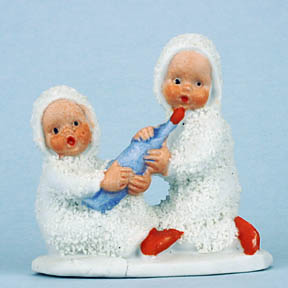Snow Baby facts for kids
A Snow Baby is a small statue, often shaped like a child. These cute figures usually show scenes from Christmas or winter sports. Traditional Snow Babies are made from a special kind of porcelain called bisque. They look like a child wearing a snowsuit. The suit is covered in tiny pieces of crushed bisque, which makes it look like real snowflakes have fallen on it. Sometimes, Snow Babies also look like other characters, such as Santa Claus, elves, penguins, or polar bears.
The first Snow Babies were made in Germany in the 1890s. They were usually all white with a painted face, or they had soft, pastel colors. When World War I started, factories stopped making them. After the war, production started again, but the new Snow Babies were not as detailed. In the 1920s, companies in Japan began making copies. These were often not as good quality as the German ones. Later, in the late 1980s, an American company called Department 56 started making new Snow Babies in Taiwan.
Contents
The Story of Snow Babies
Snow Babies were first created in the 1890s by Johann Moll. He was a German candy maker. He designed them to be reusable decorations for cakes. His idea came from older sugar dolls used as Christmas decorations in the early 1800s. At first, Hertwig and Company made them. Soon, other porcelain factories in Germany also started creating these popular figures.
How Snow Babies Became Famous
The release of Snow Babies happened around the same time as a famous event. In 1893, Admiral Robert Peary was on a trip to the North Pole. His daughter was born in Greenland during this trip. She was the first non-native baby born so far north. The local Inuit people called her "snow baby." People were very interested in Marie and the discovery of the North Pole in 1909. This helped make the Snow Baby figurines even more popular.
Snow Babies Around the World
At first, Snow Babies were only sold in Germany. But in the 1900s, German makers began sending them to England and the United States. Between 1900 and 1930, they became very popular in England as cake decorations. In the United States, women's magazines showed them as fun Christmas decorations.
Snow Babies and the Wars
Production of Snow Babies in Germany stopped during World War I. The factories had to help with the war effort. After the war, they started making them again. In the 1930s, a company in New York City, Shackman Company, helped Japanese factories make copies of Snow Babies. These Japanese figures were not as detailed as the German ones. However, they became popular because people felt less friendly towards German products after the war.
German factories stopped making Snow Babies again when World War II began. People in America also stopped wanting them as much. For a short time after that war, Snow Babies were made in the United States and England. But these figures were not very good quality, and they did not sell well.
Snow Babies became popular again in 1987. This happened when the American company Department 56 started making new versions. They copied the original Snow Baby designs.
How Snow Babies Are Made
Snow Babies are small figurines made from porcelain. They are shaped by pouring liquid porcelain into a mold. This process is called slipcasting. The figures show a child wearing a one-piece snowsuit. After the porcelain hardens, it gets a special coating. This coating contains tiny bits of material that make it feel like snow. Then, the figures are heated in a hot oven, which is called firing. Finally, they are painted.
Early Snow Baby Designs (Before World War I)
Before World War I, Snow Babies were usually 5 to 7 inches tall. They showed children doing winter activities like skiing, ice skating, and sledding. Their faces had many small details. The paint was baked onto the porcelain. This made the colors last a very long time. Some figures had different pastel colors, while others were all white except for their painted faces. There were also Snow Baby dolls with movable parts. Some Snow Babies were even used to decorate planters, boxes, and candles.
Later Snow Baby Designs (After World War I)
When Snow Baby production started again after the war, the figures were smaller. They were usually 1 to 3 inches tall. The new paint colors were bright, like red, blue, and yellow. However, these Snow Babies had fewer details on their faces. The paint also did not last as long and could flake off easily.
New poses were created, showing children singing Christmas carols, riding polar bears, or building snowmen. New characters also appeared. These included Santa Claus, elves, penguins, and dogs.
See also


